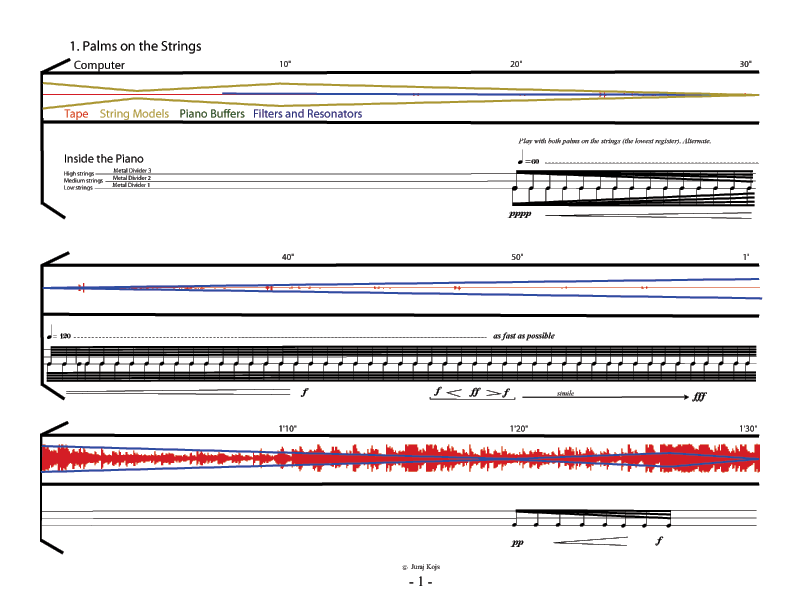
Juraj Kojs
Three Movements (2004)
for unprepared piano and electronics
“Last night I was a cypress tree, a small bed of tulips, a field of grapevines.” (Jelaluddin Rumi)
This piece presents a journey from a physically driven sonic environment into
a virtual one. The human player activates the piano strings and keys. The computer
responds to the sounds of these with various transformational processes (e.g.
filtering and timbral modification). Starting in the second movement, the pianist’s
action becomes an excitation mechanism for the virtual string. During the third
movement, the string develops into an autonomously driven instrument. First,
the model responds to the impulses provided by the piano and controls the piano
timbre. Later, it is liberated from its functional dependence on piano and directed
to its own pitch and timbre world.
The electronics part was realized in MAX/MSP. The patch is included on the data
CD. The score consists of two staff systems: one for computer and one for piano.
The graphic representation of the computer part is purely referential. The outlined
gestures, in particular those of the live-electronics, change from performance
to performance. The piano staves present detailed instructions. It is recommended
for the piano player to use a stopwatch.
Three Movements for unprepared piano and electronics was completed under guidance
of Judith Shatin at the University of Virginia in February 2004. Many thanks
go to Stefania Serafin for allowing me to use her string physical model.Duration:
ca. 21 minutes and 15 seconds
Individual Movements
1. Palms on the Strings (piano, tape, and live electronics) Audio
Example 1 (J. Kojs, piano, 1.1MB)
The player performs inside the piano by striking and rubbing the strings, and
hitting the metal dividers between the string areas. A microphone should be
positioned inside the piano. At the beginning, the piano sound may be identified.
As the movement progresses, the real-time filters and resonators transform the
sonicscape into an ethereal percussive-string collage. The score and piano set
up are described in the following paragraphs.
2. Sliding Quietly (piano and live electronics) Audio
Example 2 (J. Kojs, piano, 1.1MB)
The player slides fingertips on the keyboard without producing any pitch. A
unidirectional microphone should be positioned on each side of the keyboard
(ca. above C2 and C7) to capture the signal. The signal is used as a plucking
mechanism for the physical model of the string.
3. Bowed Fingertips (piano and live electronics) Audio
Example 3 (J. Kojs, piano, 1.1MB)
In the opening, the pianist plays on the keys lightly without producing any
pitch. In the middle section, the performer depresses the keys harder to produce
tones. Pitch emerges to be transformed by the real-time interaction with a choir
of virtual strings. The piece concludes with the predominant sonorities of virtual
strings.
Technical Requirements for the performance:
3 microphones, an Apple computer running MAX/MSP (OS 10.2 or higher), MOTU 828
Firewire Audio Console, and 2-4 channel audio system